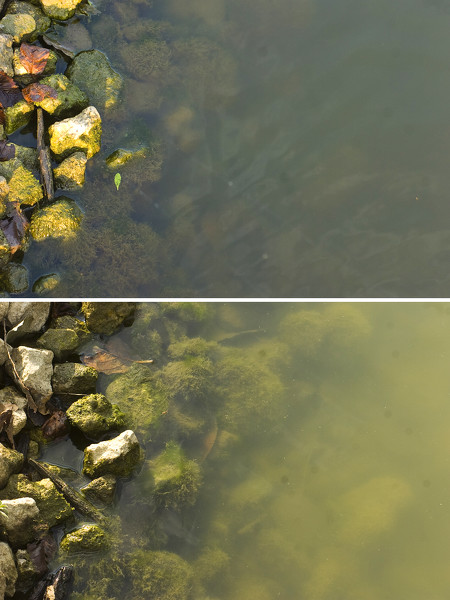Wednesday, April 8th, 2020
Officials hope alum will help clear beach
By Sydney Albert

File Photo/The Daily Standard
These photos show water at Harmon's Landing in Grand Lake before, left, and after an alum treatment on Sept. 24, 2010.
CELINA - Lake Facilities Authority officials approved spending $13,500 to treat the roughly 8-acre area of lake at the West Beach with alum in an effort to make it safe for swimming.
Alum neutralizes phosphorus, the favorite food of the toxin-producing blue-green algae in the lake.
Theresa Dirksen of Ag Solutions said during Tuesday's meeting that officials were looking to treat the partially enclosed beach at Grand Lake St. Marys State Park area with alum in early May. Aqua Doc of Chardon submitted the lone bid. Dirksen said other companies she had contacted declined to bid on the project.
The contract would cover a one-time treatment, but Dirksen said officials plan to test the water to see if and when additional treatments would be needed.
This will not be the first time alum has been used in the 13,500-acre recreational lake.
The state in 2011 ran pilot tests at three sites using alum. The West Beach received granular alum; the 7.6-acre state park campground lagoon received a pretreatment of peroxide and then liquid alum; and 5.3 acres at the Windy Point east channel received a higher dose of liquid alum.
The state spent $8.4 million on separate treatments in 2011 and 2012 when alum was applied to the 4,936-acre center of the lake with results that were positive but short-lived and produced no lasting effect. The treatments were not considered optimal, as they would have been cost prohibitive.
Local officials hope to create a safe swimming site at West Beach.
During the course of the $500,000 West Beach project last year, the state dredged about 41,000 cubic yards of nutrient-rich sediment from the 8-acre area, put down a sand base in the beach area and extended by 400 feet the rock wall that had stretched around part of the mouth of the enclosed area. The state also installed aerators and a 50-foot-long air curtain. The curtain reduces the flow of water from the open lake into the beach area.
Microcystin toxins produced by the lake's blue-green algae can harm the liver, cause gastrointestinal symptoms and rashes and can sicken people and kill small animals. Phosphorus-fed toxic blue-green algal blooms have resulted in state-issued water advisories on Grand Lake every year since 2009. The local watershed is the only one in the state designated as distressed due to unsafe algal toxin levels, a designation the watershed received in January 2011 after animals and humans were sickened by the toxins in 2010.
Excess nutrient runoff helps feed the blue-green algae that produces microcystin. Studies show that phosphorus found in manure is the nutrient that most contributes to algal growth in the lake and that most runoff comes from agricultural land, the biggest land use in the 58,000-acre, livestock-heavy watershed located in Mercer and Auglaize counties that drains into Grand Lake.
In other business, LFA members approved an addendum to modify the closing date on the Gilliland property to be on or before April 30. The LFA had previously agreed to purchase the 16.321-acre property located off Club Island Road for $399,864.50, with plans to transform the property into a wetland area.
The current unexpended fund balance for the LFA is about $2.6 million. Year-to-date revenue is $476,144.80, while year-to-date expenses are $639,258.33.
LFA members also,
• approved holding an environmental covenant ensuring proper maintenance of the wetlands installed at Windy Point.
• approved a $22,500 invoice from Access Engineering for Gilliland Project services and a $400 invoice from Knapke Law Office for title exam and document preparations.
